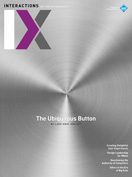Authors:
Meredith Morris, Andreea Danielescu, Steven Drucker, Danyel Fisher, Bongshin Lee, m. schraefel, Jacob Wobbrock
Gesture-based systems are becoming ubiquitous. Tablets, phones, large displays, and even laptop computers are now commonly equipped with multitouch-recognizing screens. Third-party accessories like the Wii Nunchuck and the Xbox Kinect can also detect rich gestural input. To design for these increasingly prolific gesture-based systems, we need to understand how to identify and design good gestures in these contexts (a "good" gesture may be one that meets design criteria such as discoverability, ease-of-performance, memorability, or reliability). Gesture elicitation is one promising approach to this challenge. Gesture elicitation (e.g., [1]) is a technique that emerges from the field of participatory design.…
You must be a member of SIGCHI, a subscriber to ACM's Digital Library, or an interactions subscriber to read the full text of this article.
GET ACCESS
Join ACM SIGCHIIn addition to all of the professional benefits of being a SIGCHI member, members get full access to interactions online content and receive the print version of the magazine bimonthly.
Subscribe to the ACM Digital Library
Get access to all interactions content online and the entire archive of ACM publications dating back to 1954. (Please check with your institution to see if it already has a subscription.)
Subscribe to interactions
Get full access to interactions online content and receive the print version of the magazine bimonthly.






